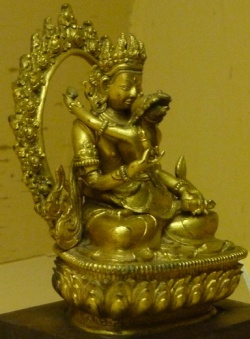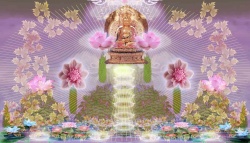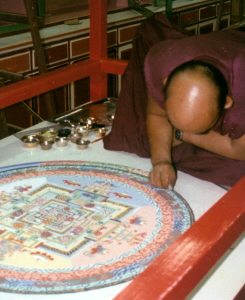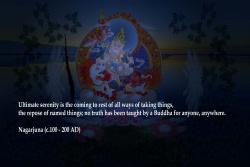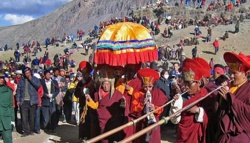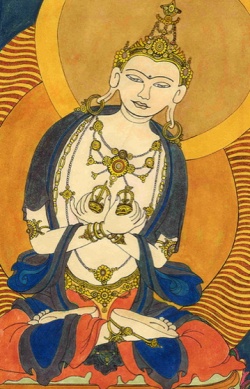Difference between revisions of "Yoga tantra"
| (One intermediate revision by one other user not shown) | |||
| Line 9: | Line 9: | ||
Nomenclature, {{Wiki|orthography}} and {{Wiki|etymology}} | Nomenclature, {{Wiki|orthography}} and {{Wiki|etymology}} | ||
| − | '[[Yogatantra]]' ([[Tibetan]]: {{BigTibetan|[[རྣལ་འབྱོར་རྒྱུད]]}}, Wylie: [[rnal 'byor rgyud]]) | + | '[[Yogatantra]]' ([[Tibetan]]: {{BigTibetan|[[རྣལ་འབྱོར་རྒྱུད]]}}, [[Wylie]]: [[rnal 'byor rgyud]]) |
Praxis | Praxis | ||
| − | [[Yoga tantra]] involves '[[deity yoga]]' ([[Tibetan]]: {{BigTibetan|[[ལྷའི་རྣལ་འབྱོར]]}}, Wylie: [[lha'i rnal 'byor]]; [[Sanskrit]]: [[Devata-yoga]]). | + | [[Yoga tantra]] involves '[[deity yoga]]' ([[Tibetan]]: {{BigTibetan|[[ལྷའི་རྣལ་འབྱོར]]}}, [[Wylie]]: [[lha'i rnal 'byor]]; [[Sanskrit]]: [[Devata-yoga]]). |
{{Wiki|Literature}} | {{Wiki|Literature}} | ||
| Line 23: | Line 23: | ||
The [[Yoga tantra]], or [[tantra of union]] with the [[nature]], is thus called because it emphasizes inner practice more than outer conduct. The [[abhiseka]] given here is the same as that of [[Upa]] but with the addition of the [[blessing]] of the [[vajra master]]. | The [[Yoga tantra]], or [[tantra of union]] with the [[nature]], is thus called because it emphasizes inner practice more than outer conduct. The [[abhiseka]] given here is the same as that of [[Upa]] but with the addition of the [[blessing]] of the [[vajra master]]. | ||
| − | [[View]]: In regard to [[absolute truth]] the [[practitioner]] realizes the [[non-conceptual]], [[ultimate nature]] and its expression – [[luminosity]]. As result of this [[realization]], within the context of perfect [[relative truth]], [[phenomena]] appear as the “[[mandala]] of [[adamantine]] [[space]]” ([[vajradhatu mandala]]). | + | [[View]]: In regard to [[absolute truth]] the [[practitioner]] realizes the [[non-conceptual]], [[Wikipedia:Absolute (philosophy)|ultimate]] [[nature]] and its expression – [[luminosity]]. As result of this [[realization]], within the context of {{Wiki|perfect}} [[relative truth]], [[phenomena]] appear as the “[[mandala]] of [[adamantine]] [[space]]” ([[vajradhatu mandala]]). |
[[Meditation]]: During formal [[meditation]] the [[practitioner]] [[visualizes]] himself as a [[deity]] and invites from the [[buddhafield]] a [[wisdom deity]] similar in [[form]] to himself, who usually remains in the [[space]] before the [[practitioner]]. The relationship between the [[deity]] and the [[practitioner]] is one of equals or friends. During objectless [[meditation]]e [[practitioner]] merges his [[perception]] of [[phenomena]] with the [[absolute]] [[nature]] [[beyond]] {{Wiki|characteristics}} and rests in evenness. [[Phenomena]] are thus seen as the play of [[wisdom]] [[manifesting]] as [[deities]]. | [[Meditation]]: During formal [[meditation]] the [[practitioner]] [[visualizes]] himself as a [[deity]] and invites from the [[buddhafield]] a [[wisdom deity]] similar in [[form]] to himself, who usually remains in the [[space]] before the [[practitioner]]. The relationship between the [[deity]] and the [[practitioner]] is one of equals or friends. During objectless [[meditation]]e [[practitioner]] merges his [[perception]] of [[phenomena]] with the [[absolute]] [[nature]] [[beyond]] {{Wiki|characteristics}} and rests in evenness. [[Phenomena]] are thus seen as the play of [[wisdom]] [[manifesting]] as [[deities]]. | ||
| Line 29: | Line 29: | ||
[[Action]]: The [[practitioner]] still strives for [[accomplishment]] through achieving the “good” and eschewing the “bad.” Chief importance is given to the [[yoga]] of the [[deity]] and the [[practitioner]] strives to [[benefit]] others. | [[Action]]: The [[practitioner]] still strives for [[accomplishment]] through achieving the “good” and eschewing the “bad.” Chief importance is given to the [[yoga]] of the [[deity]] and the [[practitioner]] strives to [[benefit]] others. | ||
| − | Fruit: [[Realization]] is attained in three lifetimes. | + | Fruit: [[Realization]] is [[attained]] in three lifetimes. |
[[kun rig]] - 1) [[sarvavid]]. [[samvedana]]. [[knowledge]]. perceiving / [[knowing]] all; [[all-aware]]; [[awareness]] of everything. 2) abbr. of {[[kun rig rnam par snang mdzad]]}, [[Sarvavid-Vairochana]]; [[Adi-buddha]] belonging to the [[Sarva Durgati Parishodhana Tantra]]; class of [[Yoga Tantra]]; popular in [[Sakya tradition]]; [[rites]] performed for the deceased [RY] | [[kun rig]] - 1) [[sarvavid]]. [[samvedana]]. [[knowledge]]. perceiving / [[knowing]] all; [[all-aware]]; [[awareness]] of everything. 2) abbr. of {[[kun rig rnam par snang mdzad]]}, [[Sarvavid-Vairochana]]; [[Adi-buddha]] belonging to the [[Sarva Durgati Parishodhana Tantra]]; class of [[Yoga Tantra]]; popular in [[Sakya tradition]]; [[rites]] performed for the deceased [RY] | ||
| Line 43: | Line 43: | ||
[[rtog pa bsdus pa'i rgyud]] - [[Compendium of Conception Tantra]]. One the [[Four Major Sections of Yoga Tantra]] [RY] | [[rtog pa bsdus pa'i rgyud]] - [[Compendium of Conception Tantra]]. One the [[Four Major Sections of Yoga Tantra]] [RY] | ||
| − | [[dam tshig bcu bzhi]] - fourteen commitments of [[Yoga Tantra]], see fourteen basic violations of the commitments; [TRS 114-4] [RY] | + | [[dam tshig bcu bzhi]] - fourteen [[commitments]] of [[Yoga Tantra]], see [[fourteen basic violations of the commitments]]; [TRS 114-4] [RY] |
| − | [[dam tshig bcu gsum]] - thirteen commitments of [[Yoga Tantra]]. {{Wiki|equivalent}} to the eleven commitments of [[Kriya tantra]], with the addition of the commitments not to drink [[water]] in a locality inhabited by violators of commitments {[[lung gcig chu la mi btung]]} and not to converse with such violators {[[nyams dang kha mi bsre ba bsrung]]} [RY] | + | [[dam tshig bcu gsum]] - thirteen [[commitments]] of [[Yoga Tantra]]. {{Wiki|equivalent}} to the eleven [[commitments]] of [[Kriya tantra]], with the addition of the [[commitments]] not to drink [[water]] in a locality inhabited by violators of [[commitments]] {[[lung gcig chu la mi btung]]} and not to converse with such violators {[[nyams dang kha mi bsre ba bsrung]]} [RY] |
[[rdo rje rtse mo'i rgyud]] - [[Vajra Pinnacle Tantra]]. One the Four Major [[Sections]] of [[Yoga Tantra]] [RY] | [[rdo rje rtse mo'i rgyud]] - [[Vajra Pinnacle Tantra]]. One the Four Major [[Sections]] of [[Yoga Tantra]] [RY] | ||
| Line 72: | Line 72: | ||
3) {[[yo ga]]} the [[three outer tantras]], [[[Kriya]], Upa, [[yoga]]], [Syn. {[[dka' thub rigs byed kyi theg pa]]}; [[three outer tantras]]; three outer [[sections]] of [[tantra]] [RY] | 3) {[[yo ga]]} the [[three outer tantras]], [[[Kriya]], Upa, [[yoga]]], [Syn. {[[dka' thub rigs byed kyi theg pa]]}; [[three outer tantras]]; three outer [[sections]] of [[tantra]] [RY] | ||
| − | [[phyi thub pa rgyud kyi theg pa gsum]] - [[Three Vehicles]] of the [[Outer Tantras]] of Austere [[Awareness]]. [[Kriya Tantra]], [[Ubhaya]]. or [[Charya Tantra]], and [[Yoga Tantra]] [[vehicles]] [RY] | + | [[phyi thub pa rgyud kyi theg pa gsum]] - [[Three Vehicles]] of the [[Outer Tantras]] of [[Austere]] [[Awareness]]. [[Kriya Tantra]], [[Ubhaya]]. or [[Charya Tantra]], and [[Yoga Tantra]] [[vehicles]] [RY] |
| − | ([[bar chad kun sel kyi chos skor]]) - Here is a short introduction to the [[Barchey Künsel]] cycle: The [[Barchey Künsel]] is the [[heart essence]] of the accomplished [[master]] [[Padmasambhava]] who [[perceives]] the three times in the entirety. It is the quintessence of one billion [[heart]] [[sadhanas]] of the [[Guru]], the most unique [[terma]] buried in the land of [[Tibet]]; and it is the first among the [[Four Cycles of Guru Sadhana]]. This [[Guru's]] [[Heart Practice]] that Dispels all {{Wiki|Obstacles}} contains in [[completeness]] all the profound key points of the [[view]], [[meditation]] and conduct of the [[Three Inner Tantras]]. | + | ([[bar chad kun sel kyi chos skor]]) - Here is a short introduction to the [[Barchey Künsel]] cycle: The [[Barchey Künsel]] is the [[heart essence]] of the accomplished [[master]] [[Padmasambhava]] who [[perceives]] the three times in the entirety. It is the quintessence of one billion [[heart]] [[sadhanas]] of the [[Guru]], the most unique [[terma]] [[Wikipedia:burial|buried]] in the land of [[Tibet]]; and it is the first among the [[Four Cycles of Guru Sadhana]]. This [[Guru's]] [[Heart Practice]] that Dispels all {{Wiki|Obstacles}} contains in [[completeness]] all the profound key points of the [[view]], [[meditation]] and conduct of the [[Three Inner Tantras]]. |
| − | It [[manifested]] from the secret treasury of the [[great wisdom]], the vast [[realization]] of the [[Second Buddha]] of [[Uddiyana]], [[Guru Rinpoche]], as the [[self-existing]] natural [[vajra]] {{Wiki|sounds}} in perfect melodious tones. Its expressions that are unmodified by the {{Wiki|intellect}} of [[ordinary people]], its words that are without [[delusion]], and its meaning that is unmistaken, are exclusively due to the [[kindness]] of the three powerful [[knowledge-holders]] [[Khyentse]], [[Kongtrül]], and [[Chokling]], the great [[beings]] of the three families, who [[incarnated]] as [[masters]] to compile and propagate an ocean of [[secret teachings]]. | + | It [[manifested]] from the secret treasury of the [[great wisdom]], the vast [[realization]] of the [[Second Buddha]] of [[Uddiyana]], [[Guru Rinpoche]], as the [[self-existing]] natural [[vajra]] {{Wiki|sounds}} in {{Wiki|perfect}} melodious tones. Its {{Wiki|expressions}} that are unmodified by the {{Wiki|intellect}} of [[ordinary people]], its words that are without [[delusion]], and its meaning that is unmistaken, are exclusively due to the [[kindness]] of the three powerful [[knowledge-holders]] [[Khyentse]], [[Kongtrül]], and [[Chokling]], the great [[beings]] of the three families, who [[incarnated]] as [[masters]] to compile and propagate an ocean of [[secret teachings]]. |
| − | It is exclusively through their [[kindness]] that this [[teaching]] was established in [[writing]] as the [[splendor]] of unending {{Wiki|welfare}} and [[happiness]] for the [[disciples]] in the Land of Snow, and propagated to flourish everywhere. This [[pure]] and [[perfect teaching]], which effortlessly bestows, in accordance with one's wishes, the all-encompassing supreme and common [[siddhis]], temporaily and ultimately, was an unprecedented diffusion of the gemstones of the profound meaning, like opening up for the treasury of the [[universal monarch]]. | + | It is exclusively through their [[kindness]] that this [[teaching]] was established in [[writing]] as the [[splendor]] of unending {{Wiki|welfare}} and [[happiness]] for the [[disciples]] in the [[Land of Snow]], and propagated to flourish everywhere. This [[pure]] and [[perfect teaching]], which effortlessly bestows, in accordance with one's wishes, the all-encompassing supreme and common [[siddhis]], temporaily and ultimately, was an unprecedented diffusion of the gemstones of the [[profound meaning]], like opening up for the treasury of the [[universal monarch]]. |
| − | [[DILGO KHYENTSE]] About the [[Barchey Künsel]] practice, which is the first and most extensive of the [[Four Cycles of Guru Sadhana]], [[Jamgön Kongtrül]] says in his Seed of the Great {{Wiki|Sal Tree}}: "Generally, for the basic descriptions of how to practice this, take the third chapter taught in the [[Sheldam Nyingjang]] as basis and apply them, following your [[teacher's]] oral advice, in the extensive, {{Wiki|medium}} or short version, whichever is appropriate, and in accordance with the situation in terms of place, [[time]], and type of [[person]]. | + | [[DILGO KHYENTSE]] About the [[Barchey Künsel]] practice, which is the first and most extensive of the [[Four Cycles of Guru Sadhana]], [[Jamgön Kongtrül]] says in his Seed of the Great {{Wiki|Sal Tree}}: "Generally, for the basic descriptions of how to practice this, take the third [[chapter]] [[taught]] in the [[Sheldam Nyingjang]] as basis and apply them, following your [[teacher's]] oral advice, in the extensive, {{Wiki|medium}} or short version, whichever is appropriate, and in accordance with the situation in terms of place, [[time]], and type of [[person]]. |
| − | Whether you begin development or completion, first perform the general preliminaries of the fourfold [[mind-training]] and the four special preliminaries. For the main part, according to the system of [[Terchen Chokgyur Lingpa]], take [[Sheldam Nyingjang]] as basis, and first practice [[Dharmakaya]] [[Amitayus]] followed by the [[Lotus Magical Net]] of [[Sambhogakaya]], the Great [[Compassionate]] One [[Avalokiteshvara]]. | + | Whether you begin [[development]] or completion, first perform the general preliminaries of the fourfold [[mind-training]] and the four special preliminaries. For the main part, according to the system of [[Terchen Chokgyur Lingpa]], take [[Sheldam Nyingjang]] as basis, and first practice [[Dharmakaya]] [[Amitayus]] followed by the [[Lotus Magical Net]] of [[Sambhogakaya]], the Great [[Compassionate]] One [[Avalokiteshvara]]. |
| − | After that, combine the extensive or {{Wiki|medium}} version with the [[Nirmanakaya]] [[Padmasambhava]], whichever is suitable, and complete the set number [of recitations] for approach and [[accomplishment]]. Following that, it is necessary to perform [[successively]] the specific approaches, combining the twelve [[manifestations]] with [[Trinley Nyingpo]], and complete the four [[activities]] and the four ancillary practices as well as the practice of the [[teaching]] guardians. According to the system of the [[omniscient]] [[master]], [[Padma Ösel Do-Ngak Lingpa]] [[Jamyang Khyentse Wangpo]]], perform, as the beginning of the main part, the single [[mudra]] according to the [[Gyüngyi Köljang]], the Daily Practice Manual, as 'approach'; the condensed outer [[mandala]] of [[Trinley Nyingpo]] as the 'full approach;' [[Trinley Dringpo]], the {{Wiki|Medium}} Practice Manual, as '[[accomplishment]];' and [[Trinley Gyepa]], the Extensive Practice Manual, together with [[Dzapkyi Köljang]], the Recitation Manual, and so forth in a detailed way for the 'great [[accomplishment]].' | + | After that, combine the extensive or {{Wiki|medium}} version with the [[Nirmanakaya]] [[Padmasambhava]], whichever is suitable, and complete the set number [of [[recitations]]] for approach and [[accomplishment]]. Following that, it is necessary to perform [[successively]] the specific approaches, [[combining]] the twelve [[manifestations]] with [[Trinley Nyingpo]], and complete the four [[activities]] and the four ancillary practices as well as the practice of the [[teaching]] guardians. According to the system of the [[omniscient]] [[master]], [[Padma Ösel Do-Ngak Lingpa]] [[Jamyang Khyentse Wangpo]]], perform, as the beginning of the main part, the single [[mudra]] according to the [[Gyüngyi Köljang]], the [[Daily Practice Manual]], as 'approach'; the condensed outer [[mandala]] of [[Trinley Nyingpo]] as the 'full approach;' [[Trinley Dringpo]], the {{Wiki|Medium}} Practice Manual, as '[[accomplishment]];' and [[Trinley Gyepa]], the [[Extensive Practice Manual]], together with [[Dzapkyi Köljang]], the [[Recitation Manual]], and so forth in a detailed way for the 'great [[accomplishment]].' |
| − | The [[samadhis]] and [[visualizations]] for recitation of these should conform with the [[root text]] of the third chapter [of [[Sheldam Nyingjang]]]. Having properly performed the four aspects of approach and [[accomplishment]], perform then the 'specific practices' such as those for [[Dharmakaya]], [[Sambhogakaya]] and so forth, whichever is suitable. There is no difference between following either of these two systems since they both are [[lords]] of these profound teachings." [RY] | + | The [[samadhis]] and [[visualizations]] for {{Wiki|recitation}} of these should conform with the [[root text]] of the third [[chapter]] [of [[Sheldam Nyingjang]]]. Having properly performed the four aspects of approach and [[accomplishment]], perform then the 'specific practices' such as those for [[Dharmakaya]], [[Sambhogakaya]] and so forth, whichever is suitable. There is no difference between following either of these two systems since they both are [[lords]] of these profound teachings." [RY] |
[[bla na med pa'i rnal 'byor gyi rgyud]] - [[Unsurpassed Yoga Tantra]] [RY] | [[bla na med pa'i rnal 'byor gyi rgyud]] - [[Unsurpassed Yoga Tantra]] [RY] | ||
| Line 96: | Line 96: | ||
[[dbang drug]] - six [[empowerments]]. (according to [[Yoga Tantra]]) [RY] | [[dbang drug]] - six [[empowerments]]. (according to [[Yoga Tantra]]) [RY] | ||
| − | [[ma rgyud]] - mother class; [[mother tantra]]; [[Mother Tantras]]. a class of [[Unsurpassed]] [[Yoga Tantra]]. (subdivision of [[Anuttara-yoga tantra]] {{Wiki|emphasizing}} [[luminosity]] / '[[od gsal]]) [RY] | + | [[ma rgyud]] - [[mother class]]; [[mother tantra]]; [[Mother Tantras]]. a class of [[Unsurpassed]] [[Yoga Tantra]]. (subdivision of [[Anuttara-yoga tantra]] {{Wiki|emphasizing}} [[luminosity]] / '[[od gsal]]) [RY] |
[[rtsa ba'i rgyud de kho na nyid bsdus pa]] - [[Tatvasamgraha Root Tantra]]. One the Four Major [[Sections]] of [[Yoga Tantra]] [RY] | [[rtsa ba'i rgyud de kho na nyid bsdus pa]] - [[Tatvasamgraha Root Tantra]]. One the Four Major [[Sections]] of [[Yoga Tantra]] [RY] | ||
| − | Four Nails ([[gzer bzhi]]) - These are the four nails which control life-breath {[[srog sdom gzer bzhi]]} according to [[Yoga Tantra]], namely, | + | Four Nails ([[gzer bzhi]]) - These are the four [[nails]] which control life-breath {[[srog sdom gzer bzhi]]} according to [[Yoga Tantra]], namely, |
1) the nail of [[unchanging]] [[intention]] {mi '[[gyur dgongs pa'i gzer]]} | 1) the nail of [[unchanging]] [[intention]] {mi '[[gyur dgongs pa'i gzer]]} | ||
Latest revision as of 12:07, 10 February 2017
The 'Yogatantra' (Sanskrit) 'conveyance' (Sanskrit: yana) is the most sublime of the three Outer Tantras. It includes a class of Buddhist tantric literature as well as 'praxis' (Sanskrit: sadhana) associated with this class. The Yogatantra yana is evident in both the Sarma traditions of Tibetan Buddhism as well as the Nine Yana path of the Nyingmapa tradition.
Jamgon Kongtrul (1813-1899) defines Yoga tantra by making reference to the Two Truths doctrine and 'method' (Sanskrit: upaya) and 'wisdom' (Sanskrit: prajna) and is rendered into English from the Tibetan by Guarisco and McLeod, et.al. (2005: p.128) thus:
"Yoga tantra is so named because it emphasizes the inner yoga meditation of method and wisdom; or alternatively, because based on knowledge and understanding of all aspects of the profound ultimate truth and the vast relative truth, it emphasizes contemplation that inseparably unites these two truths."
Nomenclature, orthography and etymology
'Yogatantra' (Tibetan: རྣལ་འབྱོར་རྒྱུད, Wylie: rnal 'byor rgyud)
Praxis
Yoga tantra involves 'deity yoga' (Tibetan: ལྷའི་རྣལ་འབྱོར, Wylie: lha'i rnal 'byor; Sanskrit: Devata-yoga).
Literature
Tattvasamgraha tantra
'Summation of the Real and the Glorious Paramãdya' (Sanskrit: Śriparamãdya)
The Yoga tantra, or tantra of union with the nature, is thus called because it emphasizes inner practice more than outer conduct. The abhiseka given here is the same as that of Upa but with the addition of the blessing of the vajra master.
View: In regard to absolute truth the practitioner realizes the non-conceptual, ultimate nature and its expression – luminosity. As result of this realization, within the context of perfect relative truth, phenomena appear as the “mandala of adamantine space” (vajradhatu mandala).
Meditation: During formal meditation the practitioner visualizes himself as a deity and invites from the buddhafield a wisdom deity similar in form to himself, who usually remains in the space before the practitioner. The relationship between the deity and the practitioner is one of equals or friends. During objectless meditatione practitioner merges his perception of phenomena with the absolute nature beyond characteristics and rests in evenness. Phenomena are thus seen as the play of wisdom manifesting as deities.
Action: The practitioner still strives for accomplishment through achieving the “good” and eschewing the “bad.” Chief importance is given to the yoga of the deity and the practitioner strives to benefit others.
Fruit: Realization is attained in three lifetimes.
kun rig - 1) sarvavid. samvedana. knowledge. perceiving / knowing all; all-aware; awareness of everything. 2) abbr. of {kun rig rnam par snang mdzad}, Sarvavid-Vairochana; Adi-buddha belonging to the Sarva Durgati Parishodhana Tantra; class of Yoga Tantra; popular in Sakya tradition; rites performed for the deceased [RY]
rgyud sde bzhi - Four sections of tantra. Kriya, Charya, Yoga, and Anuttara Yoga. four classes of tantra: bya rgyud, Kriya; spyod rgyud, Charya tantra; rnal 'byor rgyud, yoga tantra; bla med rnal 'byor rgyud, Anuttara Yoga tantra. Kriya Tantra, Ubhaya. or Charya Tantra, Yoga Tantra, and Unsurpassed Yoga Tantra. activity tantra, engagement tantra, yoga tantra, and highest yoga tantra [RY]
rgyud sde 'og ma gsum - Three Lower Sections of Tantra. Kriya Tantra {bya ba'i rgyud} Ubhaya. or Charya Tantra {u pa'i rgyud} or {spyod pa'i rgyud} and Yoga Tantra {rnal 'byor gyi rgyud} [RY]
mngon par byang chub pa lnga - Five Awakenings, according to Yoga Tantra. The sequence of visualization through the creation stage is as follows. emptiness {stong pa nyid} the lunar throne {zla gdan} the seed-syllables of buddha-speech {gsung yig 'bru} the hand implements symbolic of buddha-mind {thugs phyag mtshan} and the complete body of the deity {sku yongs rdzogs} Short: [[{mngon byang lnga]]} [RY]
gnyis ka - Ubhaya. 'Both' or 'twin.' The second of the three outer sections of tantra, usually known as Upa Yoga. The scriptures appeared first in Mount Jakang Chen and Cool Grove. The name refers to a combination of two aspects: the conduct of Kriya Yoga and the view of Yoga Tantra [RY]
rtog pa bsdus pa'i rgyud - Compendium of Conception Tantra. One the Four Major Sections of Yoga Tantra [RY]
dam tshig bcu bzhi - fourteen commitments of Yoga Tantra, see fourteen basic violations of the commitments; [TRS 114-4] [RY]
dam tshig bcu gsum - thirteen commitments of Yoga Tantra. equivalent to the eleven commitments of Kriya tantra, with the addition of the commitments not to drink water in a locality inhabited by violators of commitments {lung gcig chu la mi btung} and not to converse with such violators {nyams dang kha mi bsre ba bsrung} [RY]
rdo rje rtse mo'i rgyud - Vajra Pinnacle Tantra. One the Four Major Sections of Yoga Tantra [RY]
rnal 'byor - Yoga.
1) The actual integration of learning into personal experience.
2) See Yoga Tantra [RY]
rnal 'byor gyi rgyud - Yoga Tantra; yogatantra/ tantra of union [RY]
rnal 'byor rgyud - Yoga Tantra. The third of the three outer tantras: Kriya, Upa and Yoga. It emphasizes the view rather than the conduct and to regard the deity as being the same level as oneself [RY]
rnal 'byor rgyud - Yoga Tantra [RY]
rnal 'byor pa'i rgyud - Tantra Arriving ar a Wholesome Communication with Being; Yoga Tantra [RY]
dpal mchog dang po'i rgyud - Skt. Shri Paramadi Tantra, Glorious Supreme Primal Tantra. One the Four Major Sections of Yoga Tantra. A tantra of the same title is sometimes listed among the Eighteen Mahayoga Tantras as the tantra of enlightened qualities [RY]
pha rgyud - Father Tantras. a class of Unsurpassed Yoga Tantra; father tantra, male class [RY]
phyi rgyud sde gsum - Three Outer Tantra Pitakas. Kriya Tantra, Ubhaya. or Charya Tantra, and Yoga Tantra.
1) {kri ya}.
2) {su pa spyod rgyud}
3) {yo ga} the three outer tantras, [[[Kriya]], Upa, yoga], [Syn. {dka' thub rigs byed kyi theg pa}; three outer tantras; three outer sections of tantra [RY]
phyi thub pa rgyud kyi theg pa gsum - Three Vehicles of the Outer Tantras of Austere Awareness. Kriya Tantra, Ubhaya. or Charya Tantra, and Yoga Tantra vehicles [RY]
(bar chad kun sel kyi chos skor) - Here is a short introduction to the Barchey Künsel cycle: The Barchey Künsel is the heart essence of the accomplished master Padmasambhava who perceives the three times in the entirety. It is the quintessence of one billion heart sadhanas of the Guru, the most unique terma buried in the land of Tibet; and it is the first among the Four Cycles of Guru Sadhana. This Guru's Heart Practice that Dispels all Obstacles contains in completeness all the profound key points of the view, meditation and conduct of the Three Inner Tantras.
It manifested from the secret treasury of the great wisdom, the vast realization of the Second Buddha of Uddiyana, Guru Rinpoche, as the self-existing natural vajra sounds in perfect melodious tones. Its expressions that are unmodified by the intellect of ordinary people, its words that are without delusion, and its meaning that is unmistaken, are exclusively due to the kindness of the three powerful knowledge-holders Khyentse, Kongtrül, and Chokling, the great beings of the three families, who incarnated as masters to compile and propagate an ocean of secret teachings.
It is exclusively through their kindness that this teaching was established in writing as the splendor of unending welfare and happiness for the disciples in the Land of Snow, and propagated to flourish everywhere. This pure and perfect teaching, which effortlessly bestows, in accordance with one's wishes, the all-encompassing supreme and common siddhis, temporaily and ultimately, was an unprecedented diffusion of the gemstones of the profound meaning, like opening up for the treasury of the universal monarch.
DILGO KHYENTSE About the Barchey Künsel practice, which is the first and most extensive of the Four Cycles of Guru Sadhana, Jamgön Kongtrül says in his Seed of the Great Sal Tree: "Generally, for the basic descriptions of how to practice this, take the third chapter taught in the Sheldam Nyingjang as basis and apply them, following your teacher's oral advice, in the extensive, medium or short version, whichever is appropriate, and in accordance with the situation in terms of place, time, and type of person.
Whether you begin development or completion, first perform the general preliminaries of the fourfold mind-training and the four special preliminaries. For the main part, according to the system of Terchen Chokgyur Lingpa, take Sheldam Nyingjang as basis, and first practice Dharmakaya Amitayus followed by the Lotus Magical Net of Sambhogakaya, the Great Compassionate One Avalokiteshvara.
After that, combine the extensive or medium version with the Nirmanakaya Padmasambhava, whichever is suitable, and complete the set number [of recitations] for approach and accomplishment. Following that, it is necessary to perform successively the specific approaches, combining the twelve manifestations with Trinley Nyingpo, and complete the four activities and the four ancillary practices as well as the practice of the teaching guardians. According to the system of the omniscient master, Padma Ösel Do-Ngak Lingpa Jamyang Khyentse Wangpo], perform, as the beginning of the main part, the single mudra according to the Gyüngyi Köljang, the Daily Practice Manual, as 'approach'; the condensed outer mandala of Trinley Nyingpo as the 'full approach;' Trinley Dringpo, the Medium Practice Manual, as 'accomplishment;' and Trinley Gyepa, the Extensive Practice Manual, together with Dzapkyi Köljang, the Recitation Manual, and so forth in a detailed way for the 'great accomplishment.'
The samadhis and visualizations for recitation of these should conform with the root text of the third chapter [of Sheldam Nyingjang]. Having properly performed the four aspects of approach and accomplishment, perform then the 'specific practices' such as those for Dharmakaya, Sambhogakaya and so forth, whichever is suitable. There is no difference between following either of these two systems since they both are lords of these profound teachings." [RY]
bla na med pa'i rnal 'byor gyi rgyud - Unsurpassed Yoga Tantra [RY]
bla med gyi rgyud - Highest Yoga Tantra [RY]
bla med rnal 'byor gyi rgyud - Unsurpassed Yoga Tantra [RY]
dbang drug - six empowerments. (according to Yoga Tantra) [RY]
ma rgyud - mother class; mother tantra; Mother Tantras. a class of Unsurpassed Yoga Tantra. (subdivision of Anuttara-yoga tantra emphasizing luminosity / 'od gsal) [RY]
rtsa ba'i rgyud de kho na nyid bsdus pa - Tatvasamgraha Root Tantra. One the Four Major Sections of Yoga Tantra [RY]
Four Nails (gzer bzhi) - These are the four nails which control life-breath {srog sdom gzer bzhi} according to Yoga Tantra, namely,
1) the nail of unchanging intention {mi 'gyur dgongs pa'i gzer}
2) the nail of contemplation on the deity {ting 'dzin lha'i gzer}
3) the nail of mantra which is the nucleus {snying po sngags kyi gzer} and
4) the nail of activity which is the emanation and absorption of light rays {phro 'du phrin las kyi gzer} [RY]
yo ga'i rgyud sde chen po bzhi - Four Major Sections of Yoga Tantra [RY]
rig lnga - five enlightened families of Yoga Tantra [RY]
rigs chung lnga - five minor families of Yoga Tantra [RY]
gsang sngags 'og sde - Lower sections of Secret Mantra. The Three Outer Tantras: Kriya, Charya/Upa, and Yoga Tantra [RY]
bha ksha ka ra rdo rje rtse mo'i rgyud - Bhaksakara Vajra Pinnacle Tantra. A tantra belonging to Yoga Tantra [RY]
